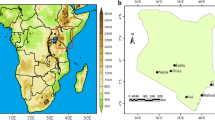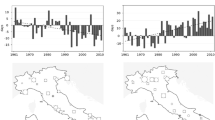Abstract
An attempt has been made, in this paper, to understand the characteristics and trends of temperatures of Kolkata, India, by using the temperature extremes, as recommended by Expert Team on Climate Change Detection and Indices (ETCCDI), and other relevant indices. For the purpose, daily maximum, minimum, and mean temperatures (1969–2012) of Alipore and Dum Dum observatories have been used. Both parametric (linear regression test) and non-parametric (Mann–Kendall test) have been done to detect the change, and Sen’s slope estimator has been used to establish the degree of change. To detect homogeneity of the dataset, four homogeneous tests have been applied. Long-term (1969–2012) trends of extreme temperature indices like TXa, TXn, TMa, TNx, TNa, and TNn of monthly, seasonal, and annual time steps significantly detect a positively increasing trend. The rate is found to be the maximum at Dum Dum. Long-term trends of TXa, TNx, TNa, TNn, and TMa indicate an average positive temperature change of 0.30 °C/decade to 0.62 °C/decade, and in extreme cases over 0.65 °C/decade. Results also point out that in the monsoon and the post-monsoon seasons most of the trends are noticeable. In most of the cases, rates of positive temperature trends have been lower in recent time period (series II, 1985–2012), compared to the past time period (series I, 1969–1995). Distribution of the relative temperature indices also points out presence of asymmetric distribution between warm nights and cold days, and cold nights. Around three times more positive increase of warm nights has been noticed at Dum Dum station during 1971–1980 and 2001–2010.






Similar content being viewed by others
References
Alexander LS (2016) Global observed long-term changes in temperature and precipitation extremes: a review of progress and limitations in IPCC assessments and beyond. Weather and Climate Extremes 11:4–16
Alexander LV, Zhang X, Peterson TC, Caesar J, Gleason B, Klein Tank AMG, Haylock M, Collins D, Trewin B, Rahimzadeh F, Tagipour A, Rupa Kumar K, Revadekar J, Griffiths G, Vincent L, Stephenson DB, Burn J, Aguilar E, Brunet M, Taylor M, New M, Zhai P, Rusticucci M, Vazquez-Aguirre JL (2006) Global observed changes in daily climate extremes of temperature and precipitation. Journal of Geophysical Research: Atmospheres 111:D05109. https://doi.org/10.1029/2005JD006290
Brázdil R, Budíková M, Auer I, Böhm R, Cegnar T, Faško P, Lapin M, Gajič-Čapka M, Zaninović K, Koleva E, Niedźwiedź T, Ustrnul Z, Szalai S, Weber RO (1996) Trends of maximum and minimum daily temperatures in central and southeastern Europe. Int J Climatol 16:765–782
Dashkhuu D, Kim JP, Chun JA, Woo-Seop L (2014) Long term trends in the daily temperature extremes over Mongolia. Weather and Climate Extremes 8:26–33. https://doi.org/10.1016/j.wace.2014.11.003
Dashkhuu D, Kim JP, Chun JA, Lee WS (2015) Long-term trends in daily temperature extremes over Mongolia. Weather and Climate Extremes 8:26–33. https://doi.org/10.1016/j.wace.2014.11.003
de Munck C, Pigeon G, Masson V, Meunier F, Bousquet P, Tréméac B, Merchat M, Poeuf P, Marchadier C (2013) How much can air conditioning increase air temperatures for a city like Paris, France? Int J Climatol 33:210–227. https://doi.org/10.1002/joc.3415
Dhorde A, Dhorde A, Gadgil AS (2009) Long-term temperature trends at four largest cities of India during the twentieth century. Journal of Indian Geophysical Union 13(2):85–97
Easterling DR, Horton B, Jones PD, Peterson TC, Karl TR, Parker DE, Salinger MJ, Razuvayev V, Plummer N, Jamason P, Folland CK (1997) Maximum and minimum temperature trends for the globe. Science 277:364–367
Fang S, Qi Y, Han G, Li Q, Zhou G (2016) Changing trends and abrupt features of extreme temperature in mainland China during 1960 to 2010. Atmosphere 7(2):22. https://doi.org/10.3390/atmos7020022
Ghasemi AR (2015) Changes and trends in maximum, minimum and mean temperature series in Iran. Atmospheric Science Letters 16:366–372. https://doi.org/10.1002/asl2.569
Guttman NB (1998) Homogeneity, data adjustments and climate normals. Source: http://www.stat.washington.edu/peter/7IMSC/Normals.pdf. Access Date 10.06.2017
Hamid AT, Sharif M, Archer D (2014) Analysis of temperature trends in Satluj River Basin, India. J Earth Sci Clim Change 5:222. https://doi.org/10.4172/2157-7617.1000222
IPCC, 2014: Climate change 2014: impacts, adaptation, and vulnerability. Part B: regional aspects. Contribution of Working Group II to the Fifth Assessment Report of the Intergovernmental Panel on Climate Change [Barros VR, CB Field, DJ Dokken, MD Mastrandrea, KJ Mach, TE Bilir, M Chatterjee, KL Ebi, YO Estrada, RC Genova, B Girma, ES Kissel, AN Levy, S MacCracken, PR Mastrandrea, LL White (eds.)]. Cambridge University Press, Cambridge, United Kingdom and New York, NY, USA, p688.
Jain SK, Kumar V (2012) Trend analysis of rainfall and temperature data for India. Curr Sci 102(1):37–49
Jaiswal RK, Lohani AK, Tiwari HL (2015) Statistical analysis for change detection and trend assessment in climatological parameters. Environmental Processes 2:729–749. https://doi.org/10.1007/s40710-015-0105-3
Ji F, Wu Z, Huang J (2014) Chassignet EP (2014) Evolution of land surface air temperature trend. Nat Clim Chang 4:462–466. https://doi.org/10.1038/nclimate2223
Kalnay E, Cai M (2003) Impact of urbanization and land-use change on climate. Nature 423:528–553
Karl TR, Jones PD, Knight RW, Kukla G, Plummer N, Razuvayev V, Gallo KP, Lindseay J, Charlson RJ, Peterson TC (1993) Asymmetric trends of daily maximum and minimum temperature. Bull Am Meteor Soc 74:1007–1023
Korade MS, Dhorde AG (2016) Trends in surface temperature variability over Mumbai and Ratnagiri cities of coastal Maharashtra. India Mausam 67(2):455–462
Kothawale DR, Deshpande NR, Rupa Kumar K (2016) Long-term temperature trends at major, medium, small cities and hill stations in India during the period 1901–2013. Am J Clim Chang 5:383–398
Kothawale DR, Revadekar JV, Rupa Kumar K (2010) Recent trends in pre-monsoon daily temperature extremes over India. Journal Earth System Science 119(1):51–65
Kothawale DR, Rupa Kumar K (2005) On the recent changes in surface temperature trends over India. Geophys Res Lett 32:L18714. https://doi.org/10.1029/2005GL023528,2005
Moberg A, Jones PD (2005) Trends in indices for extremes in daily temperature and precipitation in central and western Europe, 1901–99. Int J Climatol 25(9):1149–1171
Mohan M, Kandya A, Battiprolu A (2011a) Urban heat island effect over national capital region of India: a study using the temperature trends. J Environ Prot 2(4):465–472
Mohan M, Kikegawa Y, Gurjar B, Bhati S, Kandya A, Ogawa K (2012) Urban heat island assessment for a tropical urban Airshed in India. Atmospheric and Climate Sciences 2(2):127–138
Mohan M, Pathan SK, Narendrareddy K, Kandya A, Pandey S (2011b) Dynamics of urbanization and its impact on land-use/land-cover: a case study of Megacity Delhi. J Environ Prot 2(9):1274–1283
Oleson KW, Bonan GB, Feddema J, Jackson T (2011) An examination of urban heat island characteristics in a global climate model. Int J Climatol 31:1848–1865. https://doi.org/10.1002/joc.2201
Oza M, Kishtawal CM (2015) Spatio-temporal changes in temperature over India. Curr Sci 109(6):1154–1158
Peterson TC, Easterling DR, Karl TR, Groisman P, Nicholls N, Plummer N, Torok S, Auer I, Boehm R, Gullett D, Vincent L, Heino R, Tuomenvirta H, Mestre O, Szentimrey T, Salinger J, Førland EJ, Hanssen-Bauer I, Alexandersson H, Jones P, Parker D (1998) Homogeneity adjustments of in situ atmosphetric climate data: a review. Int J Climatol 18:1493–1517
Qu M, Wan J, Hao X (2014) Analysis of diurnal air temperature range change in the continental United States. Weather and Climate Extremes 4:86–95. https://doi.org/10.1016/j.wace.2014.05.002
Rahimzadeh F, Asgari A, Fattahi E (2009) Variability of extreme temperature and precipitation in Iran during recent decades. Int J Climatol 29:329–343. https://doi.org/10.1002/joc.1739
Rao GSP, Krishnamurthy M, Jhoshi UR, Thapliyal V (2004) Climate change over India as revealed by critical extreme temperature. Mausam 56(3):601–608
Revadekar JV, Kuma RK (2010) Recent trends in pre-monsoon daily temperature extremes over India. J Earth Syst Sci 119(1):51–65
Rupa Kumar K, Hingane LS (1988) Long term variations of surface air temperature at major industrial cities of India. Clim Change 13:287–307
Rupa Kumar K, Krishna Kumar K, Pant GB (1994) Diurnal asymmetry of surface temperature trends over India. Geophys Res Lett 21(8):677–680
Salamanca F, Georgescu M, Mahalov A, Moustaoui M, Wang M (2014) Anthropogenic heating of the urban environment due to air conditioning. J Geophys Res: Atmospheres 119:5949–5965. https://doi.org/10.1002/2013JD021225
Sharma KP, Moore B, Vorosmarty CJ (2000) Anthropogenic, climatic, and hydrologic trends in the Kosi Basin, Himalaya. Clim Change 47:141–165
Shrestha AB, Bajracharya SR, Sharma AR, Duo C, Kulkarni A (2016) Observed trends and changes in daily temperature and precipitation extremes over the Koshi river basin 1975–2010. Int J Climatol 37:1066–1083. https://doi.org/10.1002/joc.4761
Souch C, Grimmond S (2006) Applied climatology: urban climate. Progress in Physical Geography: Earth and Environment 30:270–279
Vose RS, Easterling DR, Gleason B (2005) Maximum and minimum temperature trends for the globe: an update through 2004. Geophys Res Lett 32:L23822. https://doi.org/10.1029/2005GL024379
Wijngaard JB, Kleink Tank AMG, Konnen GP (2003) Homogeneity of 20th century European daily temperature and precipitation series. Int J Climatol 23:679–692
Wu PC, Lay JG, Guo HR, Lin CY, Lung SC, Su HJ (2009) Higher temperature and urbanization affect the spatial patterns of dengue fever transmission in subtropical Taiwan. Sci Total Environ 407:2224–2233
Zhang R, Chen Zhao-Yue Ou, Chun-Quan ZY (2017) Trends of heat waves and cold spells over 1951–2015 in Guangzhou. China Atmosphere 8(2):37. https://doi.org/10.3390/atmos8020037
Acknowledgements
We would like to thank the India Meteorological Department (IMD) for providing necessary meteorological data.
Funding
We would like to thank the Centre for Scientific and Industrial Research (CSIR), Ministry of Earth Science, for funding on the research work of the first author as a Research Fellow.
Author information
Authors and Affiliations
Corresponding author
Additional information
Publisher’s note
Springer Nature remains neutral with regard to jurisdictional claims in published maps and institutional affiliations.
Supplementary Information
Below is the link to the electronic supplementary material.
Rights and permissions
About this article
Cite this article
Patra, P., Satpati, L. Characteristics and trend analysis of absolute and relative temperature extremes indices and related indices of Kolkata. Theor Appl Climatol 148, 943–954 (2022). https://doi.org/10.1007/s00704-022-03975-z
Received:
Accepted:
Published:
Issue Date:
DOI: https://doi.org/10.1007/s00704-022-03975-z




